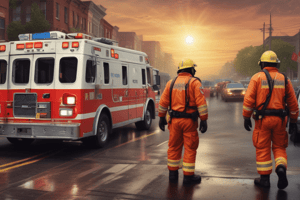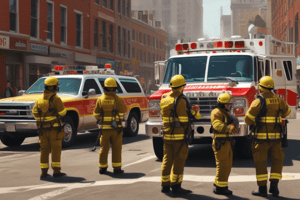Podcast
Questions and Answers
What is the primary action to take in the pre-storm phase for effective disaster management?
What is the primary action to take in the pre-storm phase for effective disaster management?
- Initiate evacuation procedures for affected areas.
- Communicate with local authorities about ongoing weather patterns.
- Fill sandbags and restock equipment. (correct)
- Make arrangements for community shelter.
What caution should be taken when a tsunami warning is issued?
What caution should be taken when a tsunami warning is issued?
- Prepare for potential trauma patients due to tsunamis. (correct)
- Follow usual traffic rules while heading inland.
- Stockpile supplies on the beach for quick access.
- Remain near the coastline to assist with evacuations.
What is a critical step to take immediately following an earthquake?
What is a critical step to take immediately following an earthquake?
- Begin repairs on damaged structures.
- Focus solely on personal safety.
- Wait for authorities to inspect before taking any action.
- Secure building contents and supply extra food and water. (correct)
Which factor is NOT associated with the risk of landslides and mudslides?
Which factor is NOT associated with the risk of landslides and mudslides?
What equipment is recommended for patient treatment and rescue operations during landslides?
What equipment is recommended for patient treatment and rescue operations during landslides?
What type of disasters can result in situations like post-hurricane looting?
What type of disasters can result in situations like post-hurricane looting?
What is a primary responsibility of EMS during emergencies?
What is a primary responsibility of EMS during emergencies?
What should be done when landmarks are missing for guiding displaced individuals?
What should be done when landmarks are missing for guiding displaced individuals?
Which personal protective equipment (PPE) is essential for safety during forest and brush fires?
Which personal protective equipment (PPE) is essential for safety during forest and brush fires?
What measures should be taken with agency vehicles before winter weather hits?
What measures should be taken with agency vehicles before winter weather hits?
What should individuals maintain in stormproof shelters during tornado preparedness?
What should individuals maintain in stormproof shelters during tornado preparedness?
How should EMS respond during a dignitary visit to a disaster site?
How should EMS respond during a dignitary visit to a disaster site?
What preparation is necessary regarding hurricanes?
What preparation is necessary regarding hurricanes?
Flashcards are hidden until you start studying
Study Notes
Types of Disasters
- Disasters are classified as natural (e.g., hurricanes, earthquakes) or human-made (e.g., riots).
- Some situations, like post-hurricane looting, combine both disaster types.
EMS Coordination
- EMS representation is critical in Emergency Operations Centers (EOC) or Unified Command Centers.
- EMS may assist with evacuation efforts and maintain communication with local EOCs.
- Coordinate emergency responses with local or state Departments of Transportation and Public Works.
Displacement and Communication
- Use lights to guide displaced individuals to emergency services when landmarks are missing.
- Prepare to transport lightly treated patients using buses or trucks.
- Radio and cell communication may fail; rely on amateur radio operators and communications experts.
Disasters and Dignitary Visits
- Dignitaries may visit disaster sites, posing crowd control and EMS protection challenges.
- EMS responsibilities can expand to include public health services, such as vaccinations.
Forest and Brush Fires
- Prioritize safety during lightning strikes; stay inside vehicles or safe structures.
- Anticipate treating firefighters for smoke inhalation, heat exhaustion, and burns.
- PPE should include fire-resistant gear, respirators, and heavy-duty gloves.
- Communicate regularly with fire command.
Winter Weather Response
- Prepare agency vehicles with snow tires, antifreeze checks, and cold weather oil if snow or ice is forecasted.
- Carry snow shovels, kitty litter, and salt for traction.
- Use alternative transportation methods, like snowmobiles, if necessary.
Tornado Preparedness
- Maintain emergency supplies in stormproof shelters for vehicles and personnel.
- After a tornado, stay in tornado-proof areas until it is safe to move.
- Support the establishment of field hospitals or first aid stations post-event.
Hurricane Response
- Identify hurricane categories and prepare for at least one category higher than anticipated.
- Use pre-storm time to fill sandbags and restock equipment, including wet weather gear and boats.
- Stay updated on post-storm conditions, such as flooding and infrastructure damage.
Tsunami Awareness
- Tsunamis can strike rapidly, often exceeding speeds of 600 mph; head inland and to higher ground if warned.
- Secure supplies with tie-down stakes and consider portable safety measures.
- Expect trauma patients due to debris and be mindful of the delayed response post-tsunami impact.
Earthquake Protocol
- Earthquakes happen with little or no warning, causing significant destruction and potential aftershocks.
- Secure building and vehicle contents; supply extra food and water for rescue personnel.
- Report any hazards from the earthquake to the EOC continuously.
Landslides and Mudslides
- Triggered by severe storms, heavy rain, or earthquakes, posing dangers to areas in the gravity pathway.
- Address potential damage to underground lines and consider alternative water delivery systems.
- Use heavy equipment like backhoes for patient treatment and rescue operations.
Types of Disasters
- Disasters are categorized into natural (hurricanes, earthquakes) and human-made (riots).
- Some scenarios, such as looting after a hurricane, can exemplify both disaster types.
EMS Coordination
- EMS plays a vital role in Emergency Operations Centers (EOCs) and Unified Command Centers.
- Essential for facilitating evacuation and maintaining communication with local EOCs.
- Collaboration with local or state Departments of Transportation and Public Works is critical for effective emergency response.
Displacement and Communication
- Lights can guide displaced individuals to emergency services when traditional landmarks are absent.
- Prepare for emergency transport of lightly treated patients using buses or trucks.
- Radio and cell communications may fail; reliance on amateur radio operators and communications experts is crucial.
Disasters and Dignitary Visits
- Dignitary visits to disaster sites create challenges in crowd control and EMS protection.
- EMS may expand responsibilities to include public health services like vaccinations during these visits.
Forest and Brush Fires
- Safety precautions during lightning strikes include staying in vehicles or safe structures.
- It's anticipated that firefighters will require treatment for smoke inhalation, heat exhaustion, and burns.
- Personal protective equipment (PPE) must consist of fire-resistant gear, respirators, and heavy-duty gloves.
- Regular communication with fire command is essential for coordinated efforts.
Winter Weather Response
- Prepare agency vehicles for winter conditions with snow tires, antifreeze checks, and cold-weather oil.
- Essential supplies include snow shovels, kitty litter, and salt for improving vehicle traction.
- If needed, alternative transportation methods like snowmobiles should be considered.
Tornado Preparedness
- Maintain emergency supplies in stormproof shelters suitable for vehicles and personnel.
- Stay in tornado-proof areas until conditions are confirmed safe post-tornado.
- Support the creation of field hospitals or first aid stations after tornado events.
Hurricane Response
- Identify hurricane categories and prepare for conditions one category higher than anticipated.
- Utilize pre-storm time for filling sandbags and restocking necessary equipment, including wet weather gear and boats.
- Stay informed about post-storm conditions including flooding and infrastructure damage.
Tsunami Awareness
- Tsunamis can occur swiftly, reaching speeds over 600 mph; immediate evacuation to higher ground is vital.
- Secure supplies using tie-down stakes, considering portable safety measures.
- Be prepared for trauma patients due to debris and understand the potential for delayed responses after a tsunami.
Earthquake Protocol
- Earthquakes may occur without warning, leading to extensive destruction and potential aftershocks.
- Secure contents in buildings and vehicles, and ensure extra food and water are available for rescue operations.
- Continuously report any hazards from earthquakes to the EOC for ongoing assessment and response.
Landslides and Mudslides
- Triggered by severe storms, heavy rainfall, or earthquakes, posing risks to areas on the gravity pathway.
- Address potential damages to underground lines and consider implementing alternate water delivery systems.
- Use heavy equipment, such as backhoes, for patient care and rescue operations in impacted areas.
Studying That Suits You
Use AI to generate personalized quizzes and flashcards to suit your learning preferences.




